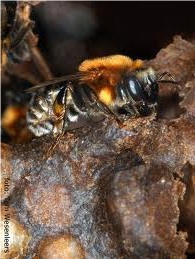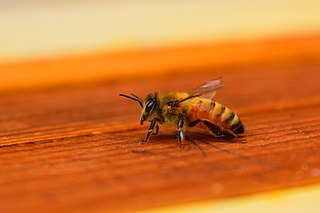
A honey bee is a eusocial flying insect within the genus Apis of the bee clade, all native to mainland Afro-Eurasia. After bees spread naturally throughout Africa and Eurasia, humans became responsible for the current cosmopolitan distribution of honey bees, introducing multiple subspecies into South America, North America, and Australia.
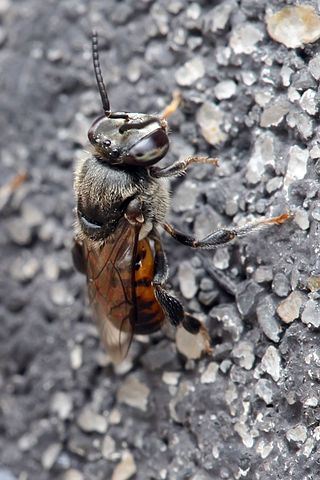
Stingless bees (SB), sometimes called stingless honey bees or simply meliponines, are a large group of bees (from about 462 to 552 described species), comprising the tribe Meliponini (or subtribe Meliponina according to other authors). They belong in the family Apidae (subfamily Apinae), and are closely related to common honey bees (HB, tribe Apini), orchid bees (tribe Euglossini), and bumblebees (tribe Bombini). These four bee tribes belong to the corbiculate bees monophyletic group. Meliponines have stingers, but they are highly reduced and cannot be used for defense, though these bees exhibit other defensive behaviors and mechanisms. Meliponines are not the only type of bee incapable of stinging: all male bees and many female bees of several other families, such as Andrenidae and Megachilidae (tribe Dioxyini), also cannot sting.
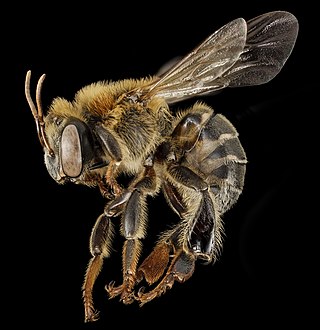
Melipona is a genus of stingless bees, widespread in warm areas of the Neotropics, from Sinaloa and Tamaulipas (México) to Tucumán and Misiones (Argentina). About 70 species are known. The largest producer of honey from Melipona bees in Mexico is in the state of Yucatán where bees are studied at an interactive park called "Bee Planet" which is within the Cuxtal Ecological Reserve.

Tetragonula carbonaria is a stingless bee, endemic to the north-east coast of Australia. Its common name is sugarbag bee. They are also occasionally referred to as bush bees. The bee is known to pollinate orchid species, such as Dendrobium lichenastrum, D. toressae, and D. speciosum. It has been identified as an insect that collects pollen from the cycad Cycas media. They are also known for their small body size, reduced wing venation, and highly developed social structure comparable to honey bees.
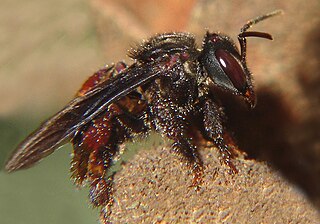
Trigona spinipes is a species of stingless bee. It occurs in Brazil, where it is called arapuá, aripuá, irapuá, japurá or abelha-cachorro ("dog-bee"). The species name means "spiny feet" in Latin. Trigona spinipes builds its nest on trees, out of mud, resin, wax, and assorted debris, including dung. Therefore, its honey is not fit for consumption, even though it is reputed to be of good quality by itself, and is used in folk medicine. Colonies may have from 5,000 to over 100,000 workers.

Tetragonisca angustula is a small eusocial stingless bee found in México, Central and South America. It is known by a variety of names in different regions. A subspecies, Tetragonisca angustula fiebrigi, occupies different areas in South America and has a slightly different coloration.

The Indian stingless bee or dammar bee, Tetragonula iridipennis, is a species of bee belonging to the family Apidae, subfamily Apinae. It was first described by Frederick Smith in 1854 who found the species in what is now the island of Sri Lanka. Many older references erroneously placed this species in Melipona, an unrelated genus from the New World, and until recently it was placed in Trigona, therefore still often mistakenly referred to as Trigona iridipennis. For centuries, colonies of T. iridipennis have been kept in objects such as clay pots so that their highly prized medicinal honey can be utilized.

Melipona bicolorLepeletier, 1836, commonly known as Guaraipo or Guarupu, is a eusocial bee found primarily in South America. It is an inhabitant of the Araucaria Forest and the Atlantic Rainforest, and is most commonly found from South to East Brazil, Bolivia, Argentina, and Paraguay. It prefers to nest close to the soil, in hollowed trunks or roots of trees. M. bicolor is a member of the tribe Meliponini, and is therefore a stingless bee. This species is unique among the stingless bees species because it is polygynous, which is rare for eusocial bees.

Plebeia remota is a species of stingless bee that is in the family Apidae and tribe Meliponini. Bees of the species are normally found in a few states in southern Brazil and their nests can be found in tree cavities. Depending on the region, P. remota may have a different morphology and exhibit different behaviors. The bee's diet consists of nectar and pollen that are collected intensely from a few sources. Researchers have conducted a multitude of studies analyzing the changes that occur in the colony during reproductive diapause and what happens during the provisioning and oviposition process or POP.

Melipona beecheii is a species of eusocial stingless bee. It is native to Central America from the Yucatán Peninsula in the north to Costa Rica in the south. M. beecheii was cultivated in the Yucatán Peninsula starting in the pre-Columbian era by the ancient Maya civilization. The Mayan name for M. beecheii is xunan kab, which translates roughly to "regal lady bee". M. beecheii serves as the subject of various Mayan religious ceremonies.

Trigona corvina is a species of stingless bee that lives primarily in Central and South America. In Panama, they are sometimes known as zagañas. They live in protective nests high in the trees, but they can be extremely aggressive and territorial over their resources. They use their pheromones to protect their food sources and to signal their location to nest mates. This black stingless bees of the tribe Meliponini can be parasitic toward citrus trees but also helpful for crop pollination.

Nannotrigona testaceicornis is a eusocial stingless bee species of the order Hymenoptera and the genus Nannotrigona. Its local common name is abelhas iraí. This species has a large geographic distribution and occupies different biomes, including urban areas, around Neotropical America. The bees of this species nest in trees or artificial cavities because of this broad distribution. N. testaceicornis is important for agriculture because it will pollinate a vast number of plant species year round.
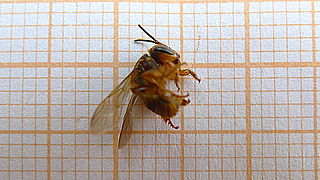
Scaptotrigona postica is a species of stingless bee that lives mainly in Brazil. It is a eusocial bee in the tribe Meliponini. S. postica is one of 25 species in the genus Scaptotrigona and is a critical pollinator of the tropical rain forests of Brazil. They construct their nests in hollowed sections of tree trunks, allowing for effective guarding at the nest entrance. This species shows colony structure similar to most members of the Meliponini tribe with three roles within the colony: queen, worker, and male. S. postica individuals have different forms of communication from cuticular hydrocarbons to pheromones and scent trails. Communication is especially useful during worker foraging for nectar and pollen through the Brazilian tropical rain forests. S. postica is a very important pollinator of the Brazilian tropical rain forests and is widely appreciated for its honey. Stingless bees account for approximately 30% of all pollination of the Brazilian Caatinga and Pantanal ecosystems and up to 90% of the pollination for many species of the Brazilian Atlantic Forest and the Amazon.

Paratrigona subnuda, commonly known as the jataí-da-terra, is a species of eusocial stingless bee in the family Apidae and tribe Meliponini. These social bees are prevalent in Neotropical moist forests, including Brazilian Atlantic and other South American forests. They inhabit spherical nests in moist underground environments with their forest habitats. Within their Neotropical habitats the P. subnuda is considered to be a very successful and common species of bee. P. subnuda’s main source of food is pollen and nectar from a large variety of native Mesoamerican tropical plants. They have been extensively studied due to social conflicts arising from single mate behaviors and particular virgin behaviors. P. subnuda also exhibits the particular daily behavior in which they open the nest entrance at dawn and close the entrance at dusk when all their activities are done.

Melipona quadrifasciata is a species of eusocial, stingless bee of the order Hymenoptera. It is native to the southeastern coastal states of Brazil, where it is more commonly known as mandaçaia, which means "beautiful guard," as there is always a bee at the narrow entrance of the nest. M. quadrifasciata constructs mud hives in the hollows of trees to create thin passages that only allow one bee to pass at a time. Because they are stingless bees, M. quadrifasciata is often used as pollinators in greenhouses, outperforming honey bees in efficiency and leading to overall larger yields of fruits that were heavier, larger, and contained more seeds.

Tetragonula hockingsi is a small stingless bee native to Australia. It is found primarily in Queensland. The colonies can get quite large, with up to 10,000 workers and a single queen. Workers of Tetragonula hockingsi have been observed in fatal fights with other Tetragonula species, where the worker bees risk their lives for the potential benefit of scarce resources.
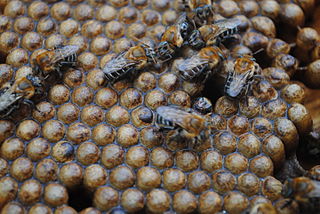
Melipona scutellaris is a eusocial stingless bee species of the order Hymenoptera and the genus Melipona. It is considered to be the reared Melipona species with the largest distribution in the North and Northeast regions of Brazil, with records from Rio Grande do Norte down to Bahia. Its common name, Uruçu, comes from the Tupi "eiru su", which in this indigenous language means "big bee". Their honey is highly desirable and the materials they create for nests have been proven to be a promising source of antibiofilm agents and to present selectivity against human cancer cell lines at low concentrations compared to normal cells.

Trigona fuscipennis is a stingless bee species that originates in Mexico but is also found in Central and South America. They are an advanced eusocial group of bees and play a key role as pollinators in wet rainforests. The species has many common names, including mapaitero, sanharó, abelha-brava, xnuk, k'uris-kab, enreda, corta-cabelo, currunchos, zagaño, and enredapelos.

Lestrimelitta limao is a neotropical eusocial bee species found in Brazil and Panama and is part of the Apidae family. It is a species of stingless bees that practices obligate nest robbing. They have never been spotted foraging from flowers, an observation that supports their raiding behavior. Because of their lack of hind corbiculae, they must raid to obtain enough protein in their diet in the form of pollen and nectar. Lestrimelitta limao secrete a lemon-scented alarm allomone, from which they receive their name, in order to conduct successful raids. L. limao are hypothesized to produce poisonous honey that is toxic if consumed by humans. Because robber bees are so rare and difficult to observe, there is a limited scope of information available.

Meliponiculture is the rational farming of stingless bees (SB), or meliponines, which is different from apiculture. In meliponiculture, the hives can be organized in meliponary, places with suitable conditions of temperature, solar orientation, humidity, and food supply.
